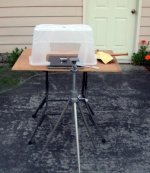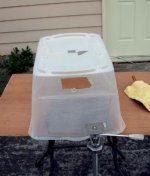J Marcus
New Member
I guess this is the best place to put this, since most of the pictures here seem to be taken by the posters. I've noticed that a lot of members express disappointment in the way their pictures come out.
After fighting with indoor photo setups and lighting for years, I finally put together a little setup using natural lighting that produces amazing pictures of small, shiny things. It brings that orient right out and costs very little. Other than camera and tripod, It can be done for less than $20.00.
I bought one of those clear, plastic, storage bins with a removeable lid for about $5.00. You can get them in many sizes. You won't need the lid. You'll be using it upside down. Cut out holes for the camera lense to "see" in. Some of these bins are rather brittle and are best cut in a well ventilated area with heat--such as a woodburning iron. If it cracks you can fix it with clear tape. Then--take sandpaper--about 120 grit perhaps, (experiment) and sand the outside of the bin until none of it is clear. It should have a very "frosted" look. I set this up on a small, moveable table. Use something like a glossy, black tile--as large as you can put under the "white box" (the bin) so that whatever is under it doesn't show. You can also use a mirror or any of a number of other bases. This works best with a very adjustable tripod for steadiness and angles. I now shoot only outdoors in natural light. I do it on cloudy days or in the evening when the sun is behind trees or whatever. Direct sun will cause glare even through the walls of the white box. If possible, shoot with the light source behind you and with a white or neutral wall beyond the box or in an open area where colored things like trees won't show through the walls of the box. The worst problem is masking as much of the camera and what is behind it (usually you) so that you don't get unnatural color and distracting reflections. You can mask around the camera and the opening in the box with white paper and clear tape. Look at some professional pictures of jewelry. That dark reflection(s) you see in the object is almost always the camera lense. You can't hide that and it usually helps to better define the surface, anyway. The differences in results are truly amazing! Also, it's cut my photo editing down to a very, bare minimum. Once I figured this out, (though I'm sure it's nothing new) I've been madly retaking all the photos for my website and replacing them. I use the original pearl or object as comparison when editing and in some cases I've even toned down the saturation a little because I thought it was just too bright and colorful for viewers to believe! All that color and beauty is there in the real thing, though, if you are using and viewing in full-spectrum, natural light. I hope that you find this useful.
J. Marcus
http://www.flyrodjewelry.com/home.html
After fighting with indoor photo setups and lighting for years, I finally put together a little setup using natural lighting that produces amazing pictures of small, shiny things. It brings that orient right out and costs very little. Other than camera and tripod, It can be done for less than $20.00.
I bought one of those clear, plastic, storage bins with a removeable lid for about $5.00. You can get them in many sizes. You won't need the lid. You'll be using it upside down. Cut out holes for the camera lense to "see" in. Some of these bins are rather brittle and are best cut in a well ventilated area with heat--such as a woodburning iron. If it cracks you can fix it with clear tape. Then--take sandpaper--about 120 grit perhaps, (experiment) and sand the outside of the bin until none of it is clear. It should have a very "frosted" look. I set this up on a small, moveable table. Use something like a glossy, black tile--as large as you can put under the "white box" (the bin) so that whatever is under it doesn't show. You can also use a mirror or any of a number of other bases. This works best with a very adjustable tripod for steadiness and angles. I now shoot only outdoors in natural light. I do it on cloudy days or in the evening when the sun is behind trees or whatever. Direct sun will cause glare even through the walls of the white box. If possible, shoot with the light source behind you and with a white or neutral wall beyond the box or in an open area where colored things like trees won't show through the walls of the box. The worst problem is masking as much of the camera and what is behind it (usually you) so that you don't get unnatural color and distracting reflections. You can mask around the camera and the opening in the box with white paper and clear tape. Look at some professional pictures of jewelry. That dark reflection(s) you see in the object is almost always the camera lense. You can't hide that and it usually helps to better define the surface, anyway. The differences in results are truly amazing! Also, it's cut my photo editing down to a very, bare minimum. Once I figured this out, (though I'm sure it's nothing new) I've been madly retaking all the photos for my website and replacing them. I use the original pearl or object as comparison when editing and in some cases I've even toned down the saturation a little because I thought it was just too bright and colorful for viewers to believe! All that color and beauty is there in the real thing, though, if you are using and viewing in full-spectrum, natural light. I hope that you find this useful.
J. Marcus
http://www.flyrodjewelry.com/home.html
Last edited:


